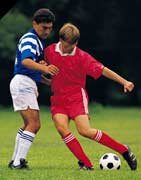A great majority of the sports out there include some sort of running as the main form of locomotion.
You may be the best thrower, catcher, passer or tackler out there, but if you can't run well, chances are you are not playing to your full capacity. Therefore, it is important to include some running training as part of your regular workouts to ensure that this aspect of your game is not lacking.
There are many different types of running workouts out there. Each is tailored for a specific purpose. Obviously, you will want to choose the one that is most applicable to your sport. Try to include all of the varieties (if possible) to these workouts because they will ensure you are trained over a broad spectrum. Improvements in one training method will transfer over and help you improve your ability in others as well.
If you play a lot of stop-and-go sports, such as football or basketball, you will want to mostly work on your sprinting ability because you are mostly using your anaerobic system in an all-out play followed by a period of rest. By increasing your sprinting ability, you will be able to put more energy into each play and recover faster between plays.
On the other hand, if soccer or tennis is more your game, and you are constantly running around the court/field, then you will want to focus more on building your endurance base so you will be able to go for a longer period of time without tiring out.
 These sports also do include some sprint activity; such as if you are sprinting to chase after the ball, so doing some interval work would also be a great option.
These sports also do include some sprint activity; such as if you are sprinting to chase after the ball, so doing some interval work would also be a great option.
How many days a week you can dedicate to your running training depends on how many other demands you have on your time.
Generally, a good time to build an endurance base is during your off-season when you are not focusing so much on skills and techniques for your sport - this is the most time-consuming type of running training.
Having a good aerobic (endurance) base also sets you up to perform sprint and speed work easier. You will already be in good condition and your body will be accustomed to the movements involved in running. Generally, working up to between 15-40 miles per week is a good guideline for ensuring you are ready for some more intense training principles to follow.
If your sport involves a great deal of running, you will most likely want to be at the higher end of the spectrum (for long distance runners, 40 miles would be a realistic number, whereas a basketball player who doesn't do quite as much continuous running would more likely be around the 15-mile mark).

Max Heart Rate & Lactate Threshold
For endurance runs, you want to work at a heart rate of about 60-75% of your max. It should be a comfortable pace that you can carry on for a longer duration without feeling like you're going to pass out at any second. You will keep the speed pretty much steady throughout the entire time and focus more on distance than any other factors.
The next type of run will be a threshold run. These runs are more intense than endurance runs but not quite as intense as interval training would be. For these runs, you want to run at a pace where you are just hovering around your lactate threshold (generally around 85% of your max heart rate).
 |
||
 |
What Is The Lactate Threshold? Lactate Threshold (LT) is the highest steady-state exercising intensity an athlete can maintain for prolonged periods of time (>30 minutes). It relates to the muscle fatigue and loss of performance that endurance athletes like cyclists, rowers, runners, swimmers and cross-country skiers experience by doing sustained high-intensity exercise. Lactate is a by-product of anaerobic metabolism that is produced during exercise, when lactate acid is produced. During light and moderate-intensity exercise, blood concentration of lactate remains low. The body is, therefore, able to remove (absorb) lactate faster than your muscles produce it. When intensity is high, there's a point when lactate absorption fails to keep up with the rate of production. This is the LT. Excessive blood lactate and hydrogen ion concentrations combine to interfere with efficient muscle contraction, and as a result, power output drops, suffering increases, and you're forced to back off. |
 |
 |
||
This will increase your body's ability to tolerate lactate that is formed in your muscles when you run at a higher intensity, thus helping you to run easier during your endurance runs and also making your sprint sessions a little more pleasant.
When you're running at threshold, you will normally only be able to maintain that pace for about 15-30 minutes so that is how long these workouts generally last. You may need to start off by doing two 10-minute sessions (with a 5-minute rest period of walking in between) and then progress to one continuous session.
If you are finding that you could run at your chosen pace for longer than 30 minutes, then it is time to increase the speed of your run, rather than the duration (and this probably indicates that you have now raised your lactate threshold!).
These runs can be incorporated into your workout once you start working on building your aerobic base and can be continued year round. They will go a long way to help you to become a better runner regardless of your sport.

Speed Workouts
Next comes speed work. This is all about stepping outside your comfort zone and pushing yourself to your limits.
The benefits are:
- Speed work will increase your fitness level more than any other form of running training in the shortest amount of time possible.
- Speed work will increase your body's ability to utilize fat for fuel at rest (and will increase your metabolism for hours after you are finished).
There are three types of speed workouts you can incorporate into your training (you can choose to do one, two, or all three, depending on your needs and frequency of training):
- Interval Training
- Speed Repetitions
- Fartlek Training
 Interval Training
Interval Training
Interval training uses time as a marker and refers to 'going hard' for a certain amount of time followed by a 'recovery' period at an easier pace for another period of time.
Generally the sprint periods last anywhere from 30 seconds to 2 minutes and are followed by rest periods of 30 seconds to 2 minutes as well. Usually, the higher intensity you are sprinting with, the longer your rest period will need to be.
For example, if you sprint for 30 seconds at max effort, you will want to take 2 minute rest periods, whereas if you sprint for 2 minutes at 90%, your rest periods may only be 1 minute.
Another approach would be to sprint at about 90% intensity for 30 seconds, but then only follow with a 30 seconds rest. Since you are not sprinting as hard, you don't need to take so long to rest and this protocol will work more on your ability to quickly clear byproducts produced by your muscles.
 Speed Repetitions
Speed Repetitions
Speed repetitions are similar to interval training only instead of going by time, you use distance as a marker. So you may choose to run 400 meter repeats, running as hard as you can for 400 meters followed by a period of recovery running for another 400 meters repeated 5-8 times.
You can use your sport specifically to help you determine how far your sprint sessions should be. If you only run short distances, the most beneficial sprints may only be 100 meter sprints repeated a number of times, whereas if you are running across an entire field you will want to do fewer longer distance sprints.
 Fartlek Training
Fartlek Training
The last form of speed training is called Fartlek. The term "fartlek" is Swedish for "speed play." Simply put, fartlek training is every type of interval training rolled into one workout.
This type of training is quite a bit more relaxed and offers a break from a planned training protocol. For this type, you basically just focus on mixing up some hard running with some easier running, dictated by how you are feeling at any given moment.
It's a good idea to do this training outside on mixed terrain so you are not only incorporating some speed to increase the intensity but are also using hills to crank it up. You can work at higher levels for various intervals of time followed by a period of rest until you feel like you have recovered.
Often this type of speed work is a good way to bust out of boredom as it allows you to be more creative during your run.

Weekly Planning
Once you are capable of performing all types of running training, you will want to create a good mix of workouts throughout the week.
 Long Run
Long Run
Generally you will have one day for your long run, followed with a day off from running both before and after. This run takes a great deal of stored glycogen, so not running the day before helps you build up for it and taking the day off afterward helps to replenish these stores.
 |
||
 |
What Is Glycogen? Glycogen is the principal stored form of carbohydrate energy (glucose), which is reserved in muscles. When your muscles are full of glycogen, they look and feel full. |
 |
 |
||
 Threshold Run
Threshold Run
Next you have your threshold day, which is medium distance and where you push yourself harder than during the long run.
 Speed Work
Speed Work
Finally include 1-2 days of speed work for a well-rounded program that will challenge both your aerobic and anaerobic capacities. Obviously you will have to ensure you are still getting proper recovery from both your running and regular training so carefully plan your running into you schedule so you don't run the risk of overtraining.
 |
||
 |
What's The Difference Between Aerobic And Anaerobic? Aerobic means "involving or improving oxygen consumption by the body". Aerobic exercise, therefore, enhances respiratory and circulatory efficiency by improving oxygen consumption. Aerobic movements require oxygen to generate force, and enlist slow-twitch muscles for activity over sustained periods of time (minutes to hours). Examples of aerobic exercise includes cardio, jogging, cycling and running marathons. Anaerobic, on the other hand, literally means "without oxygen". Anaerobic exercise, then, does not require oxygen to generate force. Anaerobic movements use fast-twitch muscles for short bursts of intense activity lasting only brief durations of time (ranging typically from a few seconds to up to a minute). Examples of anaerobic exercises includes isometric holds, sprinting and high-intensity weightlifting. |
 |
 |
||
If you are heavily loaded with other training as well, maybe only focus on one type of running training for the time being until you get more free time and can once again include all the forms.

Conclusion
By following a proper running program, you will allow yourself to become more efficient at whatever sport you play. You will find you are in better shape and able to tolerate a greater workload with your other training as well. (provided you have a well balanced plan and are not overtraining!).
 To View Overtraining Articles, Click Here.
To View Overtraining Articles, Click Here.
By incorporating a variety of forms of running training into your routine, you will keep boredom at bay and ensure that you are constantly reaching new heights with your fitness level.
Reference:
- Murphy, S. Run for Life. (2003). Kyle Cathie Limited, London.
